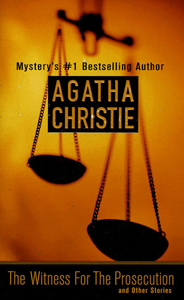“The Witness for the Prosecution and Other Stories” (1948) collects 11 Agatha Christie short stories that were originally published in magazines from 1924-47. They were collected in other volumes in the U.K. Only one story includes Hercule Poirot, and none include Miss Marple or other regulars. But they aren’t missed. I can’t think of much higher praise for a Christie collection.
Because many of these tales gain definition and meaning via their revelation at the end, it’s hard to write about them coyly. So I’ll institute a SPOILER WARNING here.
Daring themes
The supernatural (or the suggestion thereof) is the closest to an overarching theme for the collection. Christie shows interest in split personalities and the idea of multiple souls inhabiting a body, particularly in “The Fourth Man” (1947).

“The Witness for the Prosecution and Other Stories” (1948)
Author: Agatha Christie
Genres: Mystery and fantasy short stories
Settings: England, 1920s-1940s
(As an aside, note the way the quiet train car occupant – the “fourth man” — joins mid-story. I wonder if this influenced J.K. Rowling’s introduction of the supposedly sleeping Lupin in “Harry Potter and the Prisoner of Azkaban.”)
I watch a lot of horror movies, so I’m familiar with the concepts of possession and loss of self-control. But they were fresher in Christie’s time, and they still play that way today.
We also find many key figures deliberately faking out investigators (and the reader). “Accident” (1943) is a predictable yet entertaining template for the form. And “S.O.S.” (1947) – an unwieldy fantasy-tinged yarn — takes creative poisonings a step further.
2 famous stories
This book contains two of the most-adapted Christie stories. “The Witness for the Prosecution” (1925) was made into a play and twice into a film. And “Philomel Cottage” (1924) was made four times into movies called “Love from a Stranger.” One of those was alternately titled “A Night of Terror.”
Leadoff story “The Witness for the Prosecution” is a vintage, pure, perfect piece of writing. For a mystery writer, Christie doesn’t write courtroom dramas often. Maybe it’s because she can too easily dismantle the process.
Here, a defendant, with help from only one outside actor, masterfully plays his own lawyer and the system. It closes with a zinger of a final quote.
“Philomel Cottage” doesn’t stick the landing as well. But it’s a strong suspense piece, and I can see why screenwriters latched onto the possibilities.
In a marvelous scene, heroine Alix must get a message out to Dick via telephone, but her dastardly husband Gerald is in the room with her. So she strategically uses the mute button so Gerald hears something innocent and Dick hears her plea.
While “Philomel’s” love triangle is basic, it’s emotional. Christie nicely presents the three sides and shows Alix’s stress over attempting to pick the right man.
Clever cons
Among the other stories, “The Mystery of the Blue Jar” (1924) is a top-notch con story playing on the protagonist’s credulity. It’s a master class in lathering the plot with supernatural elements yet having logical explanations for everything in the end.
“The Mystery of the Spanish Shawl” (1947) is a lesser con-job piece that also finds Christie giving meta-commentary on the writing process. Her stand-in, Anthony Eastwood, says the title and the plot are the two essentials and that “everything else is spade-work.”
Despite all the fakery, this collection doesn’t leave a reader in a dark place. The author’s strong morals combine with her general belief in the English justice system to give a good guy a happy ending in “The Red Signal” (1947) and a bad guy his just desserts in “Where There’s a Will” (1926).
Granted, Christie doesn’t give the UK’s brand of justice a free pass on everything. As noted, the title story shows how it can be manipulated. “Spanish Shawl” shows the relative ease with which someone can impersonate a cop.
Also, the country’s quirk wherein a spouse cannot divorce someone who is crazy and locked in an asylum plays into multiple tales. Christie shows how a bad law – rather than addressing bad behavior — can lead to bad behavior.
Poirot pops in
The one Poirot story here is “The Second Gong” (1932). Along with “Sing a Song of Sixpence” (1947), it finds Christie in her tried-and-true territory of staging a murder at a home. Then we probe whodunit even though it seems no one could have.
But don’t read this book solely for the Belgian sleuth. “The Second Gong” is a shorter version of the novella “Dead Man’s Mirror,” which was collected in a book of that name in 1937. The longer version is more suspenseful, but even that one is a pretty basic Christie tale.
I’m surprised “The Second Gong” is included here. Its value is as a curiosity for Christie nerds, but they wouldn’t have been the target audience in 1948. I’m guessing most readers were disappointed to get a weaker version of a story they’d already read.
Today, though, Christie nerds will be glad to compare “The Second Gong” and “Dead Man’s Mirror” for a peek into how the author punches up a story with a robust editing pass.
Every week, Sleuthing Sunday reviews an Agatha Christie book or adaptation. Click here to visit our Agatha Christie Zone.


